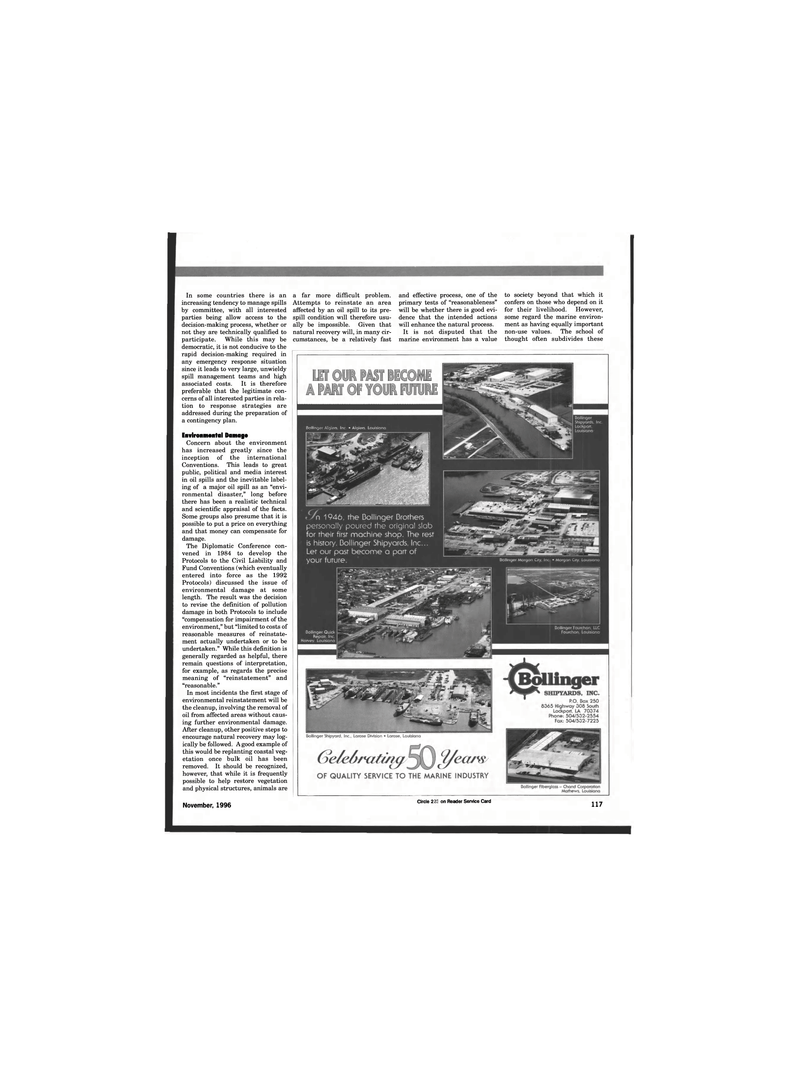
Page 115: of Maritime Reporter Magazine (November 1996)
Read this page in Pdf, Flash or Html5 edition of November 1996 Maritime Reporter Magazine
In some countries there is an increasing tendency to manage spills by committee, with all interested parties being allow access to the decision-making process, whether or not they are technically qualified to participate. While this may be democratic, it is not conducive to the rapid decision-making required in any emergency response situation since it leads to very large, unwieldy spill management teams and high associated costs. It is therefore preferable that the legitimate con- cerns of all interested parties in rela- tion to response strategies are addressed during the preparation of a contingency plan.
Environmental Damage
Concern about the environment has increased greatly since the inception of the international
Conventions. This leads to great public, political and media interest in oil spills and the inevitable label- ing of a major oil spill as an "envi- ronmental disaster," long before there has been a realistic technical and scientific appraisal of the facts.
Some groups also presume that it is possible to put a price on everything and that money can compensate for damage.
The Diplomatic Conference con- vened in 1984 to develop the
Protocols to the Civil Liability and
Fund Conventions (which eventually entered into force as the 1992
Protocols) discussed the issue of environmental damage at some length. The result was the decision to revise the definition of pollution damage in both Protocols to include "compensation for impairment of the environment," but "limited to costs of reasonable measures of reinstate- ment actually undertaken or to be undertaken." While this definition is generally regarded as helpful, there remain questions of interpretation, for example, as regards the precise meaning of "reinstatement" and "reasonable."
In most incidents the first stage of environmental reinstatement will be the cleanup, involving the removal of oil from affected areas without caus- ing further environmental damage.
After cleanup, other positive steps to encourage natural recovery may log- ically be followed. A good example of this would be replanting coastal veg- etation once bulk oil has been removed. It should be recognized, however, that while it is frequently possible to help restore vegetation and physical structures, animals are a far more difficult problem.
Attempts to reinstate an area affected by an oil spill to its pre- spill condition will therefore usu- ally be impossible. Given that natural recovery will, in many cir- cumstances, be a relatively fast and effective process, one of the primary tests of "reasonableness" will be whether there is good evi- dence that the intended actions will enhance the natural process.
It is not disputed that the marine environment has a value to society beyond that which it confers on those who depend on it for their livelihood. However, some regard the marine environ- ment as having equally important non-use values. The school of thought often subdivides these
November, 1996 Circle 325 on Reader Service Card 117

 114
114

 116
116
